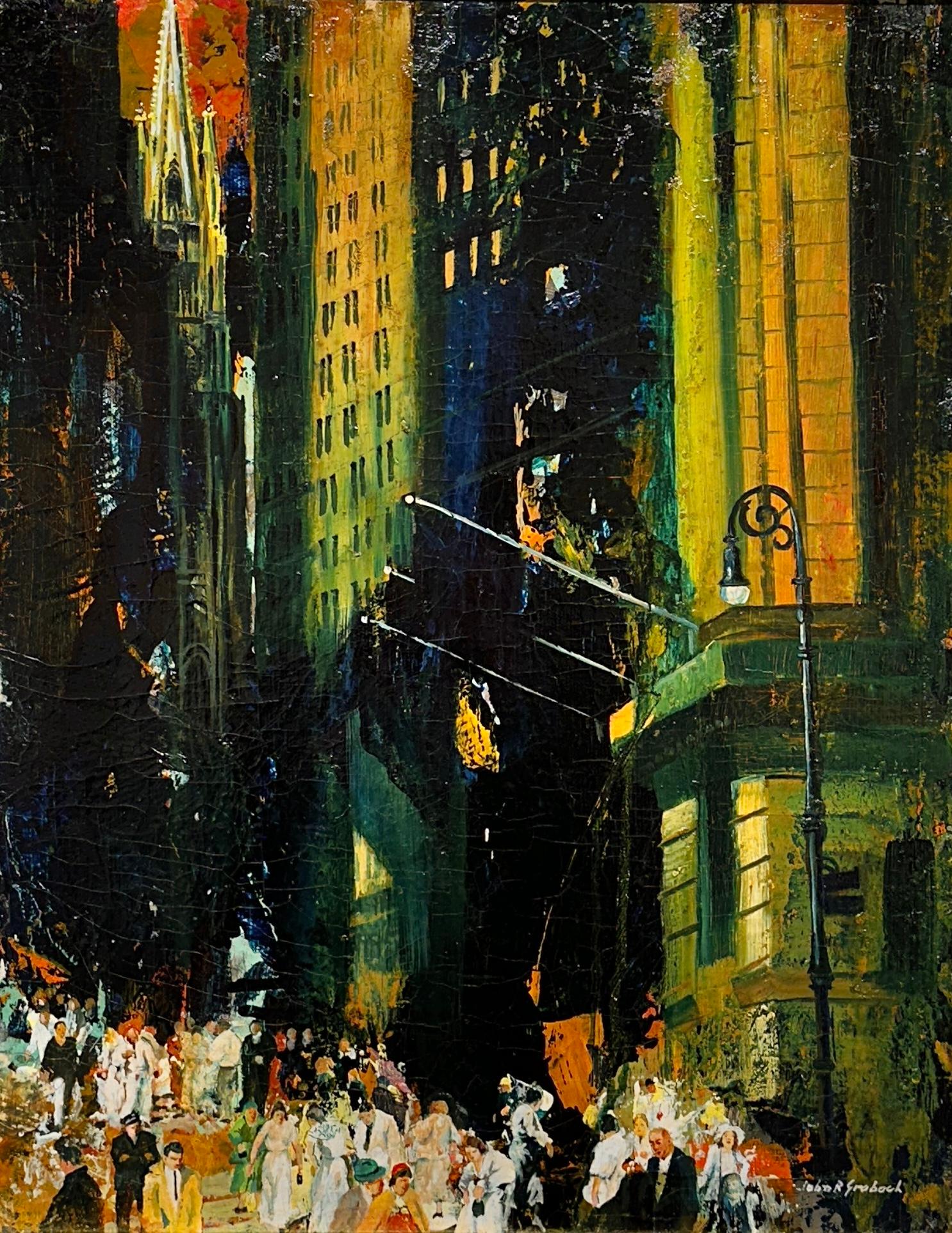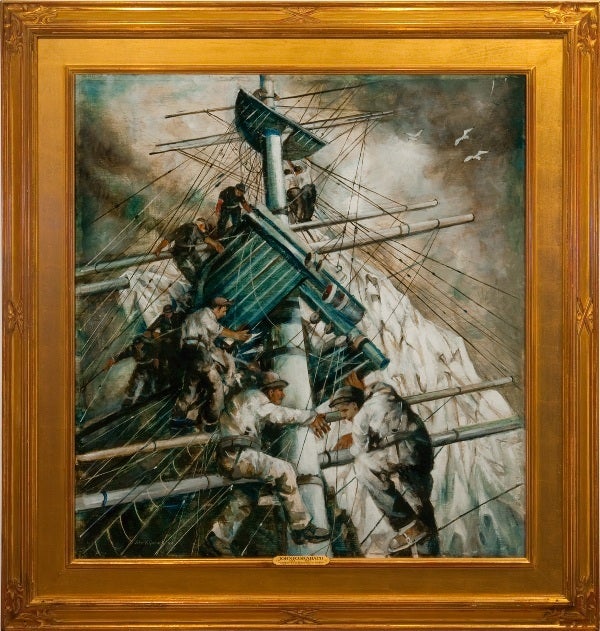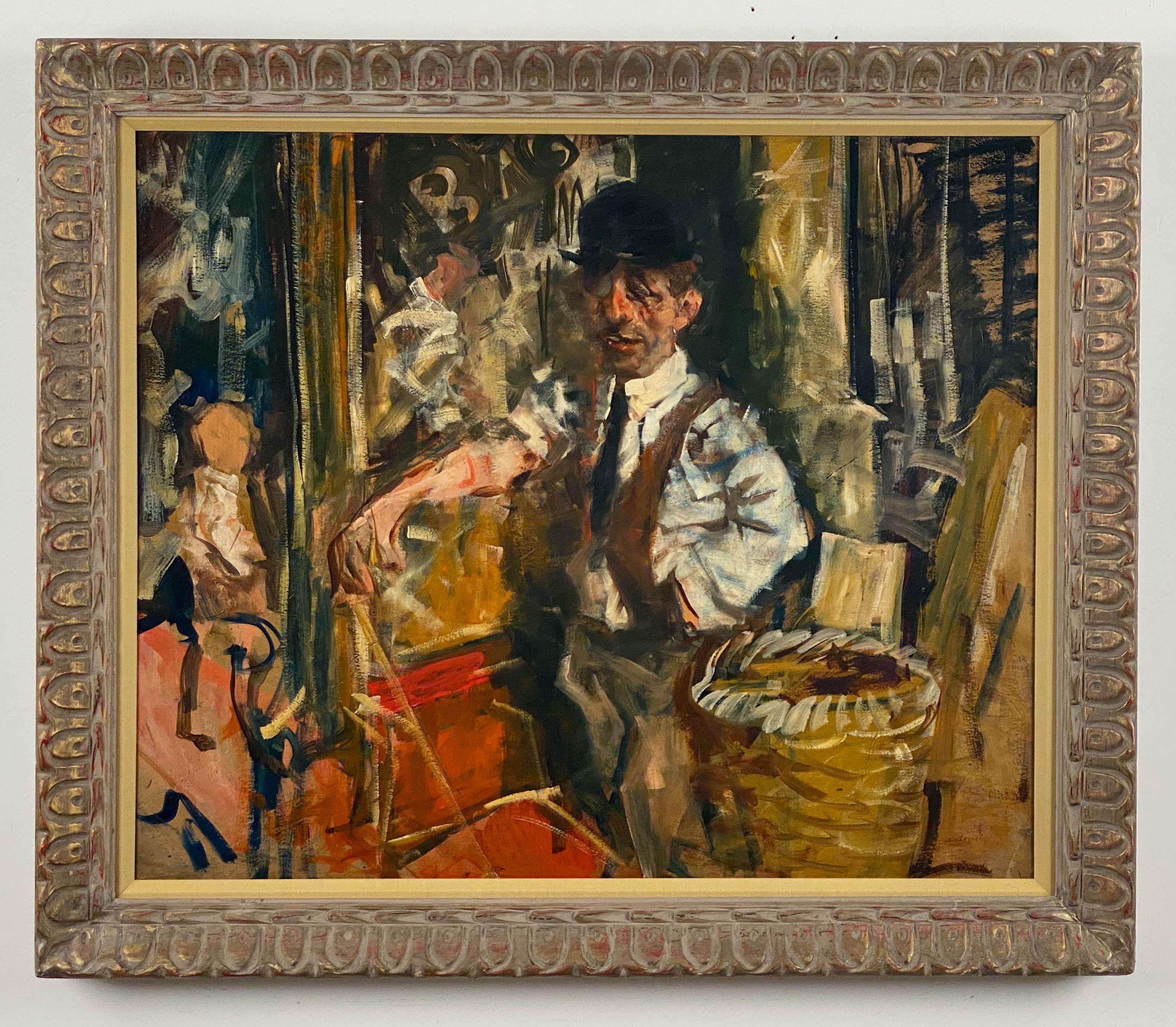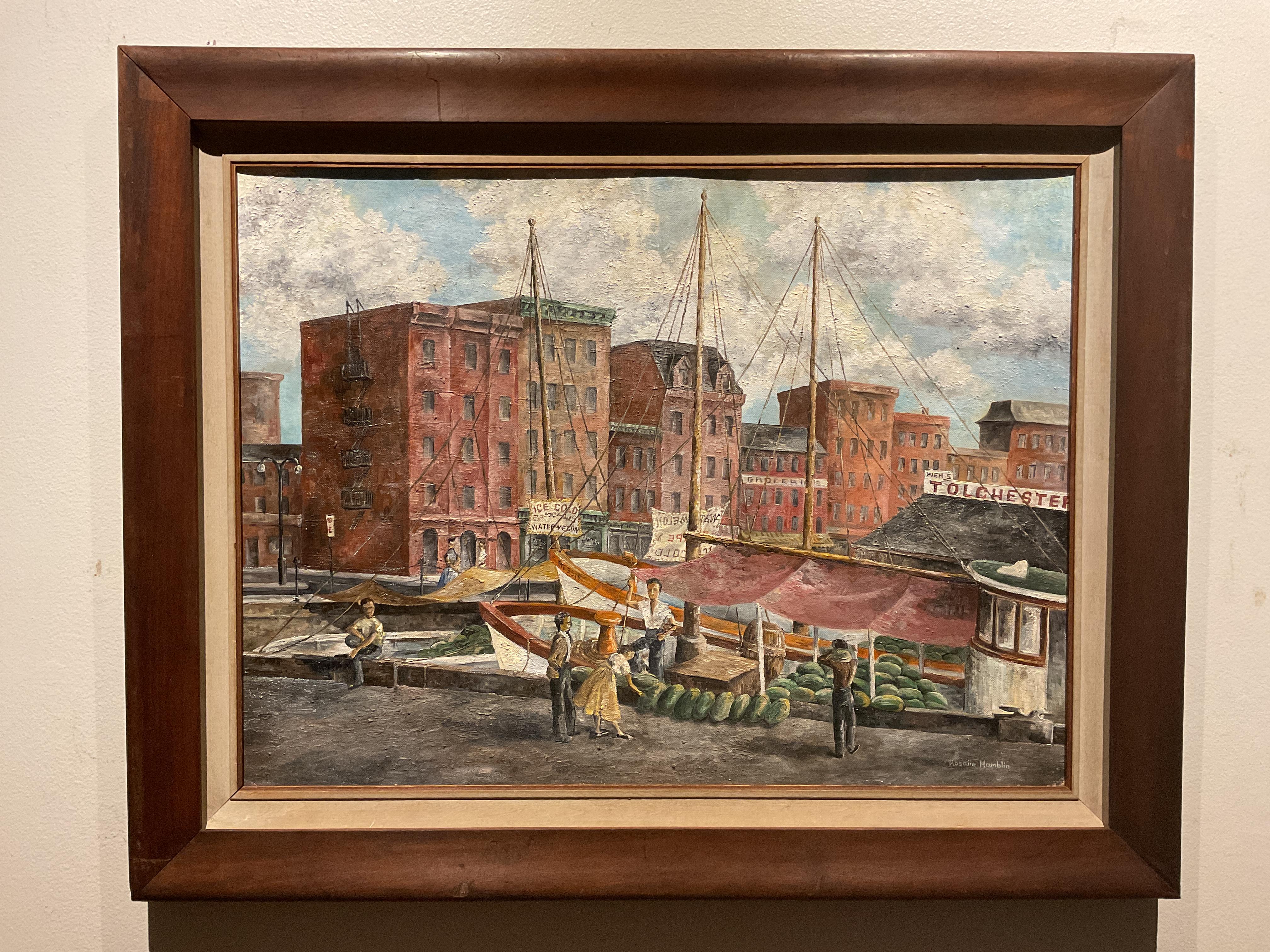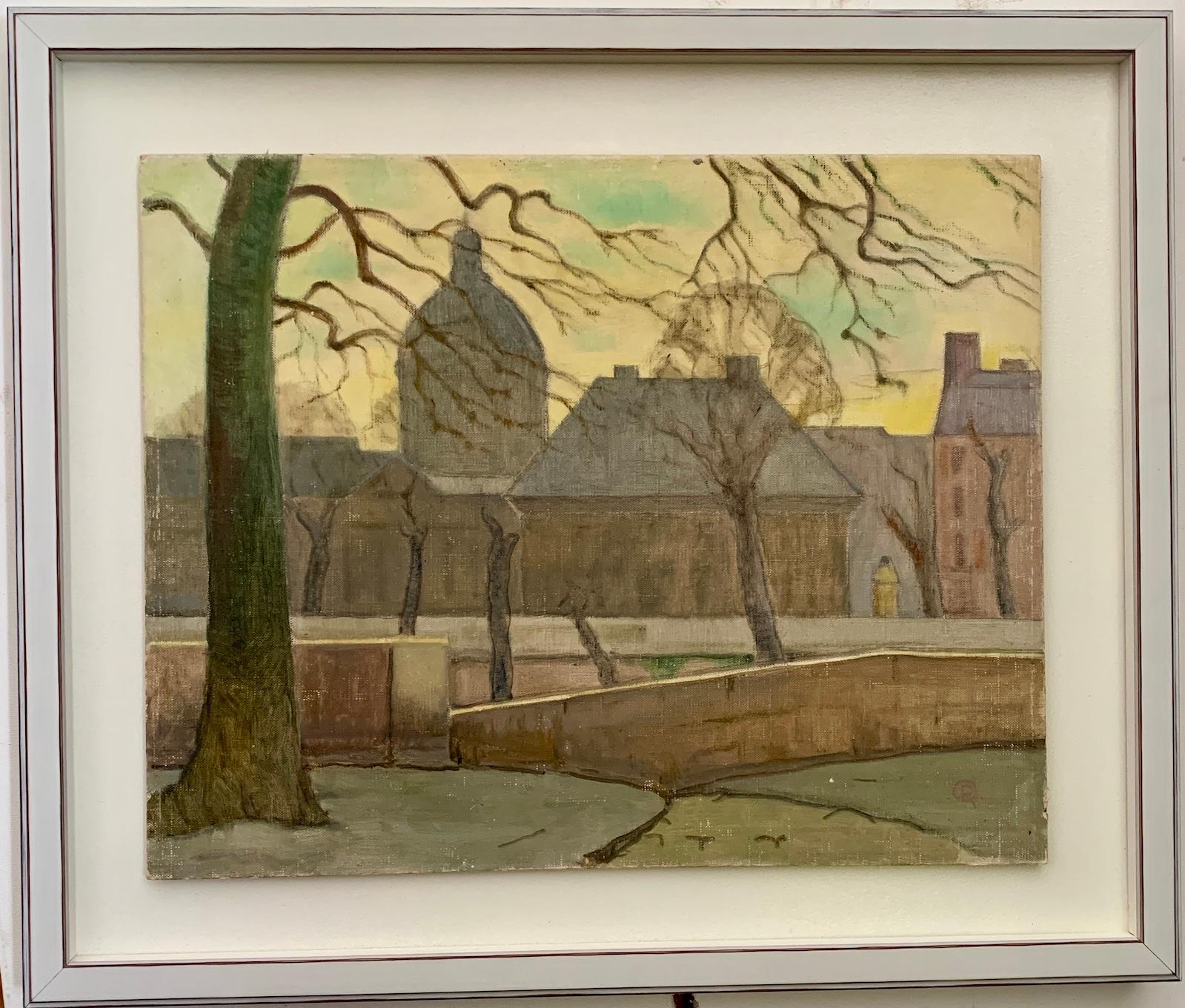Items Similar to Modernist Oil Painting the Shop Window NYC 1940s WPA era
Want more images or videos?
Request additional images or videos from the seller
1 of 8
Maurice Becker Modernist Oil Painting the Shop Window NYC 1940s WPA era
About the Item
the Shop Window New York City, 1940s
17.75X25 sight size.
Maurice Becker (1889–1975) was a radical political artist best known for his work in the 1910s and 1920s for such publications as The Masses and The Liberator.
Maurice Becker was born in Nizhni-Novgorod, Russia, the son .of ethnic Jewish parents. The family emigrated from Russia to the United States in 1892, moving to the Jewish community of the Lower East Side of New York City. His older sister was Helen Tamiris a modern dance pioneer and his brother Sam Becker was a sculptor. He studied with Ash Can (Ashcan) School artist Robert Henri in 1908. In 1913 Becker joined with Robert Henri, John Sloan, George Bellows and Stuart Davis in taking part in the famous 1913 Armory Show. Becker also began drawing cartoons. He was a great admirer of radical artists such as Art Young, Rockwell Kent and Robert Minor who were using their art in an attempt to obtain social reforms.
The young Maurice took night classes in bookkeeping and art while working days as a sign painter. He worked as an artist for the New York Tribune from 1914 to 1915, and for the Scripps newspapers from 1915 to 1918. He also contribute artwork on a freelance basis to a broad range of contemporary publications, including Harper's Weekly, Metropolitan magazine, and The Saturday Evening Post.
Maurice Becker is best remembered as an illustrator for radical magazines, most famously for the New York political and artistic magazine The Masses, to which he began to contribute in 1912.
Becker was a frequent contributor to the radical press, publishing his art in such periodicals as Revolt, The Toiler, New Solidarity, The Blast, Survey Graphic, The New York Call. and The New Masses. Becker's work, which often made use of the muted tones of graphite or charcoal, was likewise generally softer in political tone than the more hard-edged and biting work of his peers, who included Art Young, Fred Ellis, Robert Minor, Hugo Gellert, and William Gropper.
From 1921 to 1923, Becker lived in Mexico, where he worked as an artist for El Pulsa de México, an English-language magazine. After that time, he dedicated himself to painting full-time, essentially ending his career as a political artist for magazines. He did occasionally contribute art to political publications after that date, however, such as an apolitical drawing entitled "Summer," which ran in the August 1926 issue of The New Masses.
Becker remained a political radical throughout his life. He visited the Soviet Union in 1931. His name appeared on the letterhead of the Artists' Front to Win the War and he was a signatory to the call for formation of the American Artists' Congress. Maurice Becker died in 1975. He was included in the MoMA show Murals by American painters and photographers 1932, along with Ben Shahn, Stuart Davis, Bernice Abbott, George Biddle, Ernst Fiene and many other WPA and FSA artists.
Rebecca Zurier, Art for the Masses: A Radical Magazine and Its Graphics, 1911-1917. Philadelphia: Temple University Press.
- Creator:Maurice Becker (1889, American)
- Dimensions:Height: 28 in (71.12 cm)Width: 20.5 in (52.07 cm)
- Medium:
- Movement & Style:
- Period:
- Condition:cracks to the surface of the board that are stable and don't go through.
- Gallery Location:Surfside, FL
- Reference Number:1stDibs: LU38212637692
About the Seller
4.9
Platinum Seller
These expertly vetted sellers are 1stDibs' most experienced sellers and are rated highest by our customers.
Established in 1995
1stDibs seller since 2014
1,559 sales on 1stDibs
Typical response time: 1 hour
- ShippingRetrieving quote...Ships From: Surfside, FL
- Return PolicyA return for this item may be initiated within 3 days of delivery.
More From This SellerView All
- Bathers at the Quarry 1940s American Modernist Oil Painting WPA eraBy Theresa Berney LoewLocated in Surfside, FLSwimmers and sun tanners at the local watering hole. Her birth name was Theresa Berney. At the time of her passing she was known as Theresa Loew. Birth place: Baltimore artist, blo...Category
1940s American Modern Landscape Paintings
MaterialsOil, Board
- Modernist Landscape Oil PaintingBy Donald Roy PurdyLocated in Surfside, FLGenre: Modern Subject: Figures Medium: Oil Surface: Board Country: United States signed lower left Donald Roy Purdy is an American painter whose work evolved through a range of styl...Category
20th Century Fauvist Figurative Paintings
MaterialsOil, Board
- Large Modernist Oil Painting 1940s, Judaica Hasidic Shtetl Wagon Driver WPA EraBy Emanuel Glicenstein RomanoLocated in Surfside, FLGenre: Modern Subject: Landscape with figure of horse, driver and wagon Medium: Oil Surface: wood Board EMANUEL ROMANO Rome, Italy, b. 1897, d. 1984 Emanuel Glicen Romano was born in Rome, September 23, 1897. His father Henryk Glicenstein was a sculptor and was living in Rome with his wife Helena (born Hirszenberg) when Emanuel was born. His father obtained Italian citizenship and adopted the name Enrico. Emanuel was brought up in Italy, Switzerland, Germany, England and Poland. In 1926 Emanuel Glicenstein Romano and his father sailed for New York. They briefly visited Chicago. Romano's sister, Beatrice, and mother only joined them in New York years later. Romano changed his name on his arrival to America and some have erroneously speculated that this was to avoid antisemitic discrimination. In truth, as the son of a highly-regarded artist, Romano changed his name to ensure that any success or recognition he would later attain, would be the result of nothing other than his own merit as an artist, and not on account of his father's fame. In 1936 Romano was worked for the WPA Federal Art Project creating murals. ( there were many jewish artists active with in the WPA period. notably Chaim Gross, Ben Shahn, Isaac and Moses Soyer, Abraham Rattner and many others. During and immediately after World War II, Romano created a series of allegorical works depicting graphic holocaust images that were held closely by the family until after his passing. One of these works is now on permanent display in the Florida Holocaust Museum in St. Petersburg Florida. Emanuel's father died in 1942 in a car accident before they could realize their shared dream of visiting Israel. In 1944 Romano, having completed his degree at the Pennsylvania Academy of Fine Arts and the Art Institute of Chicago, began teaching at the City College of New York. Romano moved to Safed, Israel in 1953 and established an art museum in his father's memory, the Glicenstein Museum. COLLECTIONS Indianapolis Museum of Art Metropolitan Museum of Art Boston Fine Arts Museum Fogg Museum Musée Nacional de France Recently his work has been added to the Florida Holocaust Museum collection. His notable works include his holocaust themed allegorical paintings as well as portraits of Marianne Moore, his father and William Carlos Williams...Category
1930s American Modern Figurative Paintings
MaterialsOil, Board
- Simka Simkhovitch WPA Artist Oil Painting Gouache American Modernist PowerlineBy Simka SimkhovitchLocated in Surfside, FLSimka Simkhovitch (Russian/American 1893 - 1949) This came with a small grouping from the artist's family, some were hand signed some were not. These were studies for larger paintings. Simka Simkhovitch (Симха Файбусович Симхович) (aka Simka Faibusovich Simkhovich) (Novozybkov, Russia May 21, 1885 O.S./June 2, 1885 N.S.—Greenwich, Connecticut February 25, 1949) was a Ukrainian-Russian Jewish artist and immigrant to the United States. He painted theater scenery in his early career and then had several showings in galleries in New York City. Winning Works Progress Administration (WPA) commissions in the 1930s, he completed murals for the post offices in Jackson, Mississippi and Beaufort, North Carolina. His works are in the permanent collections of the Dallas Museum of Art, the National Museum of American Art and the Whitney Museum of American Art. Born outside Kyiv (Petrograd Ukraine) into a Jewish family who owned a small department store. During a severe case of measles when he was seven, Simcha Simchovitch sketched the views outside his window and decided to become an artist, over his father's objections. Beginning in 1905, he studied at the Grekov Odessa Art School and upon completion of his studies in 1911 received a recommendation to be admitted to the Imperial Academy of Arts. Though he enrolled to begin classes in architecture, painting, and sculpture at the Imperial Academy, he was dropped from the school roster in December because of the quota on the number of Jewish students and drafted into the army. Simchovitch served as a private in the 175th Infantry Regiment Baturyn [ru] until his demobilization in 1912. Re-enrolling in the Imperial Academy, he audited classes. Simka Simkhovitch exhibited paintings and sculptures in 1918 as part of an exhibition of Jewish artists and in 1919 placed 1st in the competition "The Great Russian Revolution" with a painting called "Russian Revolution" which was hung in the State Museum of Revolution. In 1922, Simkha Simkhovitch exhibited at the International Book Fair in Florence (Italian: Fiera Internazionale del Libro di Firenze). In 1924, Simkhovitch came to the United States to make illustrations for Soviet textbooks and decided to immigrate instead. Initially he supported himself by doing commercial art and a few portrait commissions. In 1927, he was hired to paint a screen for a scene in the play "The Command to Love" by Fritz Gottwald and Rudolph Lothar which was playing at the Longacre Theatre on Broadway. Art dealers began clamoring for the screen and Simkhovitch began a career as a screen painter for the theater. Catching the attention of the screenwriter, Ernest Pascal, he worked as an illustrator for Pascal, who then introduced him to gallery owner, Marie Sterner. Simkhovitch's works appeared at the Marie Sterner Gallery beginning with a 1927 exhibit and were repeated the following year. Simkhovitch had an exhibit in 1929 at Sterner's on circus paintings. In 1931, he held a showing of works at the Helen Hackett Gallery, in New York City and later that same year he was one of the featured artists of a special exhibit in San Francisco at the California Palace of the Legion of Honor in Lincoln Park. The exhibit was coordinated by Marie Sterner and included four watercolors, including one titled "Nudes". He is of the generation of Russian Soviet artists such as Isaac Pailes, Serge Charchoune, Marc Chagall, Chana Orloff, Isaac Ilyich Levitan, and Ossip Zadkine. In 1936, Simkhovitch was selected to complete the mural for the WPA Post office project in Jackson, Mississippi. The mural was hung in the post office and courthouse in 1938 depicted a plantation theme. Painted on the wall behind the judge’s bench, “Pursuits of Life in Mississippi”, a depiction of black workers engaged in manual labor amid scenes of white professionals and socialites, was eventually covered over in later years during renovations due to its stereotypical African American imagery. Simka painted what he thought was typical of Jackson. His impression of pre-civil rights Mississippi was evidently Greek Revival column houses, weeping willow trees, working class families, and the oppression of African Americans. He painted African American men picking cotton, while a white man took account of the harvest and a white judge advised a white family, calling it Pursuits of Life in Mississippi. Though clearly endorsed by the government and initially generally well-received, the mural soon raised concerns with locals as the climate toward racial segregation began to change. The main concern was whether depictions that show African Americans in subjugated societal roles should be featured in a courtroom. The following year, his painting "Holiday" won praise at an exhibition in Lincoln, Nebraska. In 1940, Simkhovitch's second WPA post office project was completed when four murals, "The Cape Lookout Lighthouse and the Orville W. Mail Boat", "The Wreck of the Crissie Wright", "Sand Ponies" and "Canada Geese" were installed in Beaufort, North Carolina. The works were commissioned in 1938 and did not generate the controversy that the Jackson mural had. The main mural is "The Wreck of the Crissie Wright" and depicts a shipwreck which had occurred in Beaufort in 1866. "The Cape Lookout Lighthouse and the Orville W. Mail Boat" depicted the lighthouse built in 1859 and the mail boat that was running mail during the time which Simkhovitch was there. The boat ran mail for the area until 1957. "Sand Ponies" shows the wild horses common to the North Carolina barrier islands and "Canada Geese" showed the importance of hunting and fishing in the area. All four murals were restored in the 1990s by Elisabeth Speight, daughter of two other WPA muralists, Francis Speight...Category
1930s American Modern Landscape Paintings
MaterialsGouache, Oil, Board
- 1972 Gestural Oil Painting Boat in Harbor Figural Abstraction Raoul MiddlemanBy Raoul MiddlemanLocated in Surfside, FLRaoul Middleman (born 1935 in Baltimore, Maryland) is an American painter. Middleman has been a member of the Maryland Institute College of Art faculty since 1961. American University Museum at the Katzen Center has described Middleman as a "Baltimore maestro [whose] nudes are not pretty—they are sagging, dimpled, and real. His cityscapes reveal the underbelly of post-industrial rot, his narrative paintings give contemporary life to his personal obsessions. They are intelligent, messy, and utterly masterful." From an interview with RM "I was doing abstract art. Then Roy Lichtenstein came around, and I wanted to be current. I remember Grace Hartigan said, “You’ve gotta go to New York, seize destiny by the hand.” My friend Jon Schueler took my slides up to Eleanor Ward, who had the Stable Gallery. My Pop art paintings were discovered. I moved to New York into Malcolm Morley’s old loft down on South Street. Agnes Martin was upstairs... People who interest me come from different quarters. I knew guys around Schueler, like B.H. Friedman. But I also knew the Pop world pretty well – Al Hansen, Richard Artschwager, Lichtenstein. I became friends with Raoul Hague and I rented a place in Port Jervis, New York. I started doing my first landscapes up there. I thought making landscapes was the dumbest thing you could do. You got flies, insects, cow pies, humidity. But I loved it... I went down to the meetings of the Figurative Alliance. I met my friends there — Paul Resika, Paul Georges, Rosemarie Beck...Category
1970s American Modern Landscape Paintings
MaterialsOil, Board
- Outside the Synagogue Russian Judaica Oil PaintingBy Emmanuel SnitkovskyLocated in Surfside, FLThis piece came from the collection of the Bezalel Art Gallery on the Lower East Side of New York City. Emmanuil Snitkovsky is an internationally known artist, sculpture and poet. ...Category
1980s Modern Landscape Paintings
MaterialsCanvas, Oil, Illustration Board
You May Also Like
- New York scene done by John Grabach Artist "Trinity Church - Wall Street"Located in Rockport, MAGreat Wall Street piece by John R. Grabach (March 2, 1886 – March 17, 1981) with expressive colors and figures. Grabach was a renowned American painter, best known for his evocative...Category
1920s Ashcan School Figurative Paintings
MaterialsOil
- "After the Storm"By John R. GrabachLocated in Lambertville, NJSigned LL John Grabach was a highly regarded New Jersey artist, teacher and author of a classic text, How to Draw the Human Figure. He was born in Massachusetts, and with his widow...Category
20th Century Ashcan School Figurative Paintings
MaterialsOil, Panel
- Outside a DeliBy Jack LevineLocated in Sheffield, MAJack Levine American, 1915-2010 The Deli Oil on board 28 ¼ by 34 in. W/frame 36 ¼ by 42 in. Signed Lower Right Born and raised in the south end of Boston, Jack Levine created soc...Category
1940s Ashcan School Figurative Paintings
MaterialsOil
- Rare Baltimore Harbor Oil Painting, Pratt Street Dock, ca 1950 - Rosalie HamblinLocated in Baltimore, MDThis lively oil painting depicts Baltimore’s busy waterfront, specifically the former piers that lined Pratt Street in the Inner Harbor. Painted by local artist Rosalie Mills ( née Hamblin), the scene depicts the watermelon boats that berthed near Pier 5. The painting dates to the 1950’s. The historic buildings that once lined Pratt Street, before urban renewal clearance of the 1960’s, provide the background for the scene. Hamblin’s attention to detail is quite good and calls to mind other Baltimore painters...Category
1950s Ashcan School Figurative Paintings
MaterialsOil
- Blue Thames - panoramatic landscape cityscape London Thames buildings view blueBy Brian ElwellLocated in London, GBBrian Elwell began his artistic career at Chelsea School of Art, and was awarded the Chelsea Diploma in Fine Art and a Leverhulme Travelling Scholarship. He subsequently studied for ...Category
2010s Contemporary Landscape Paintings
MaterialsBoard, Oil
- French Mid century Impressionist, City view with Cathedral in Paris, FranceLocated in Woodbury, CTExcellent French Mid century Impressionist, City view with Cathedral in Paris, Franch The painter was active around the middle of the 20th century, painting landscapes, portraits, a...Category
1930s Impressionist Landscape Paintings
MaterialsOil, Board
Recently Viewed
View AllMore Ways To Browse
The Antique Shop
Old Shop Signs
Antique Shop Signs
Old Antique Shop
Pioneer School
American Antique Shops
1940s Dior
Antique Shop Drawing
Antique Window Art
Russian School Oil
1940s Era Art
Painted Antique Windows
Early American Window
English Antique Shop
1940s Painting Magazine
Painting Antique Windows
Nyc Antique
Night Window
